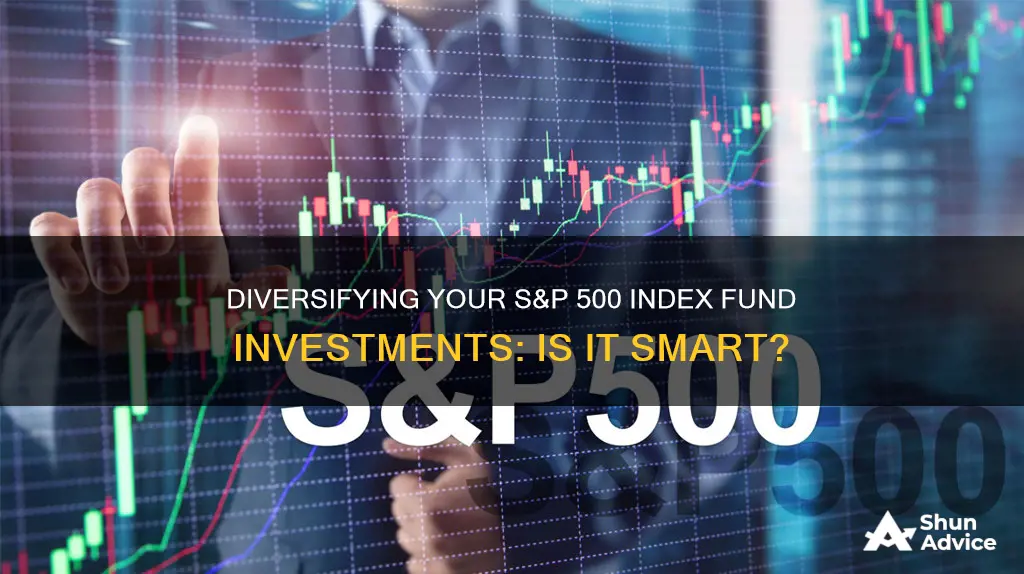
The S&P 500 is a stock market index that tracks the performance of 500 of the largest U.S. public companies by market capitalization. The easiest way to invest in the S&P 500 is to buy exchange-traded funds (ETFs) or index funds that track the index. Index funds are passively managed, which means that the fund’s managers simply buy and sell stocks to keep the fund’s asset allocation in line with the benchmark. This keeps expense ratios, the fees you pay for the upkeep of your fund, very low.
S&P 500 index funds will be nearly identical in terms of their performance and holdings, so investing in multiple funds will not necessarily further diversify your portfolio. If you have one index fund and want to diversify further, you could consider exploring index funds that cover other market indexes, such as the Dow Jones or Nasdaq.
| Characteristics | Values |
|---|---|
| Should you invest in multiple S&P 500 index funds? | Investing in multiple S&P 500 index funds will not necessarily further diversify your portfolio. |
| How to choose an S&P 500 index fund | Look for S&P 500 index funds with low expense ratios, several years of operation, and a healthy amount of assets under management (AUM). |
| How to invest in S&P 500 index funds | You can invest in the individual stocks represented in the S&P 500 or in S&P 500 index funds. |
| Difference between S&P 500 index funds and S&P 500 ETFs | S&P 500 funds, whether index funds or ETFs, both track the S&P 500. The difference is that exchange-traded funds (ETFs) can be traded throughout the day like stocks, while index funds can only be bought and sold at the price set at the end of the trading day. |
What You'll Learn

What are the advantages of investing in the S&P 500?
The S&P 500 is a stock market index that tracks the performance of 500 of the largest U.S. public companies by market capitalization, or the total value of all their outstanding shares. Here are some advantages of investing in the S&P 500:
Exposure to Dynamic Companies
Investing in the S&P 500 exposes individuals to some of the world's most dynamic companies, such as Apple, Amazon, Microsoft, and Johnson & Johnson. These companies are leaders in their respective industries and have a strong track record of financial performance.
Consistent Long-Term Returns
Although returns in any single year can vary, the S&P 500 has consistently performed well over the long term. This consistency makes it a reliable investment option for those seeking stable and steady returns.
Instant Diversification
The S&P 500 includes a diverse range of companies across multiple sectors, including information technology, financials, and healthcare. Investing in the S&P 500 provides instant diversification, reducing the risk associated with investing in individual stocks.
Passive Investment Strategy
Index funds and ETFs that track the S&P 500 follow a passive investment strategy, aiming to replicate the performance of the index. This means investors do not need to actively select stocks or time the market, making it a more hands-off investment approach.
Low Costs
Index funds and ETFs that track the S&P 500 tend to have low expense ratios compared to other types of funds. This makes them an attractive option for cost-conscious investors.
Strong Track Record
The S&P 500 has a long history and has been one of the most widely followed benchmarks in the stock market. This track record provides confidence in its performance and makes it a trusted investment option.
Direct Mutual Funds: Offline Investing Strategies and Steps
You may want to see also

What are the disadvantages of investing in the S&P 500?
Investing in the S&P 500 can be an attractive option for both seasoned and beginner investors. However, it also has some potential drawbacks. Here are some of the disadvantages of investing in the S&P 500:
Market Volatility
The S&P 500 has shown strong long-term growth potential, but it is not immune to market volatility. There can be periods of market downturns resulting in significant declines in the index value. Investors need to be prepared for short-term market fluctuations and have a long-term investment horizon.
Lack of Individual Stock Selection
Investing in the S&P 500 means giving up control over individual stock selection. While this provides diversification benefits, it may also lead to missed opportunities. Some individual stocks may outperform the broader market, and investors seeking more control over their portfolio may prefer a strategy that includes individual stock selection.
Concentration in U.S. Stocks
The S&P 500 Index primarily focuses on large-cap U.S.-based companies, which can result in limited exposure to international markets. This concentration may limit the diversification benefits that could be gained from global investments. Investors seeking broader international exposure may need to explore additional investment options.
Inclusion of Underperforming Stocks
While the S&P 500 committee periodically reviews and adjusts the index constituents, there may be instances where underperforming stocks remain in the index for a certain period. This can impact the overall performance of the index during those periods.
Overall Diversification
The S&P 500 consists solely of large-cap U.S. stocks, and true portfolio diversification includes investing in mid- and small-cap companies as well. Additionally, international companies, bonds, cash, and other asset classes should be considered alongside stocks.
Volatility and Downside Risk
The S&P 500, being an equity investment, carries inherent risks such as volatility and downside risk. Newer investors may find this volatility challenging to navigate and may prefer investments with less price fluctuation.
Vanguard Funds: Best UK Investment Options
You may want to see also

How do I choose an S&P 500 index fund?
When choosing an S&P 500 index fund, there are a few key things to consider:
- Expense ratio: This is the cost that the fund manager will charge you over the course of the year to manage the fund as a percentage of your investment. It is important to compare the expense ratios of different funds to find the most inexpensive option.
- Sales load: This is a sales commission charged by the fund manager. It is best to avoid funds that charge a sales load, as these expenses can add up over time. ETFs do not usually charge a sales load.
- Diversification: The S&P 500 index is dominated by large-cap companies, so it is important to consider whether you want exposure to small-cap and mid-cap stocks as well. You may want to look for funds that include companies across different sectors and industries to reduce your risk.
- Performance: Review the performance of the fund by accessing the fact sheet on the company's website. Look at the fund's historical returns and how it has performed compared to the overall S&P 500 index.
- Liquidity: Consider how liquid the fund is and whether you want the ability to buy and sell the fund throughout the day. ETFs are generally more liquid than index funds and can be traded during market hours.
- Fees: In addition to the expense ratio, consider any other fees or commissions charged by the fund. For example, some funds may charge loads or commissions.
- IShares S&P 500 Value ETF (IVE): This ETF offers exposure to the S&P 500 index and is known for its low fees.
- SPDR Portfolio S&P 500 Value ETF (SPY): This ETF tracks the S&P 500 index and is offered by one of the major brokerages.
- Vanguard S&P 500 Value ETF (VOO): This ETF has a very low expense ratio of 0.03% and is known for its strong performance.
- Vanguard 500 Index Fund Admiral Shares (VFIAX): This mutual fund has an expense ratio of 0.04% and is one of the largest index funds.
Remember to do your own research and consider your financial goals and risk tolerance when choosing an S&P 500 index fund. Diversification and low costs are important factors in choosing a fund that aligns with your investment strategy.
The Best Time to Invest in Funds: Morning or Evening?
You may want to see also

How do I invest in the S&P 500 with an ETF?
The S&P 500 is a stock market index composed of 500 leading U.S. companies. It is not possible to directly invest in the index itself, but you can invest in an index fund or exchange-traded fund (ETF) that tracks the index.
- Opening an Investment Account: If you don't already have one, you will need to open a brokerage account to buy investments. You can use the money deposited into this account to purchase S&P 500 stocks or funds, which will then be held within that account.
- Choosing an S&P 500 ETF: Nearly all major brokerages and fund companies offer some type of S&P 500 ETF. Examples include the iShares S&P 500 Value ETF (IVE), the SPDR Portfolio S&P 500 Value ETF (SPY), and the Vanguard S&P 500 Value ETF (VOO). When choosing an S&P 500 ETF, consider factors such as the expense ratio, liquidity, inception date, and dividend yield.
- Purchasing the S&P 500 ETF: You can purchase the selected S&P 500 ETF through a discount broker with commission-free trading. The shares of the ETF can be bought and sold throughout the trading day, similar to stocks.
- Monitoring and Managing Your Investment: After purchasing the S&P 500 ETF, regularly review its performance by accessing the fact sheet provided by the company offering the ETF. This will help you track how your investment is doing and make informed decisions about buying, holding, or selling.
Remember, investing in the S&P 500 through an ETF provides exposure to a diverse range of large-cap U.S. companies. However, it is important to consider the potential drawbacks, such as the dominance of large-cap companies and the inherent risks of equity investing.
Invest in Mutual Funds: Quick and Easy Ways
You may want to see also

What are the alternatives to investing in the S&P 500?
While the S&P 500 is a good investment option, it is not the only one. Here are some alternatives to investing in the S&P 500:
Buying the S&P 500 on an equally weighted basis
An equally weighted S&P 500 ETF holds every stock in the index in equal proportions, regardless of size or sector. This option provides greater exposure to smaller stocks trading at cheaper valuations than the S&P 500's weightings. It also reduces concentration risk, making your investment less dependent on the performance of a few companies.
Buying global stocks
International stocks are currently trading at a discount compared to US stocks, and they have higher dividends, higher exposure to the real economy, and more potential for sales growth and margin expansion. They are also likely to benefit from a weaker US dollar.
Buying value stocks
Value stocks are generally those with a low price relative to their earnings, book value, or cash flows. They are currently trading at an attractive discount compared to growth stocks and have the potential to outperform the S&P 500 in the coming years, especially in an economic environment of higher rates, higher inflation, and a focus on the real economy.
Buying small-cap stocks
Small-cap stocks are less profitable and have more volatile cash flows, but they are also cheaper and have more growth potential. They are also likely to benefit from a more inflationary environment and the reversal of trends like globalization and deregulation, which have disproportionately benefited large companies in the past.
Individual stocks
You can also buy individual stocks of companies in the S&P 500. This option may be riskier than investing in an index fund or ETF, but it can provide more flexibility and the potential for higher returns.
Other funds
There are also other funds that have outperformed the S&P 500 in certain years. For example, in 2023, 10 actively managed strategies had returns more than 20 percentage points above the S&P 500 index. These included funds from PGIM Jennison US Growth, BlackRock GF US Growth, and Natixis Loomis Sayles US Growth Equity.
While these alternatives exist, it is important to remember that investing in the S&P 500 through an index fund or ETF can still be a good choice due to its broad exposure to some of the world's most dynamic companies and its consistent long-term returns.
A Beginner's Guide to Index Fund Investing in India
You may want to see also
Frequently asked questions
The S&P 500 is a stock market index that tracks the performance of 500 of the largest U.S. public companies by market capitalization. It represents nearly 80-85% of the total capitalization of the U.S. stock market.
Investing in the S&P 500 provides exposure to some of the world's most dynamic companies and offers consistent long-term returns. It also provides instant diversification to an investor's portfolio.
S&P 500 index funds will have nearly identical performance and holdings. Investing in multiple S&P 500 index funds will not necessarily further diversify your portfolio. Instead, consider exploring index funds that cover other market indexes, such as the Dow Jones or Nasdaq, for added diversification.







